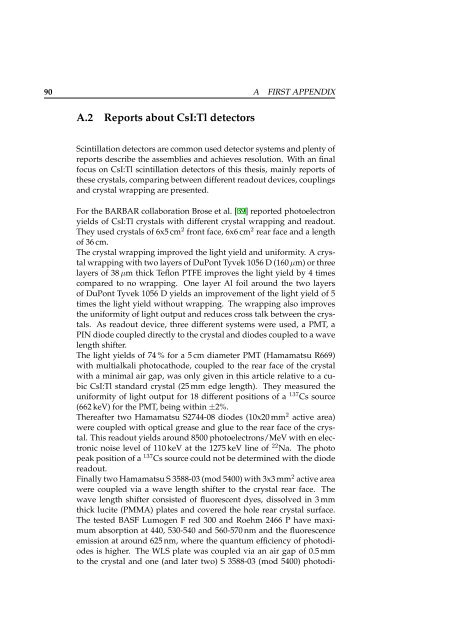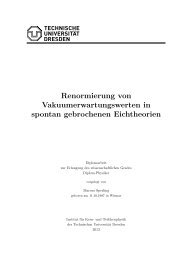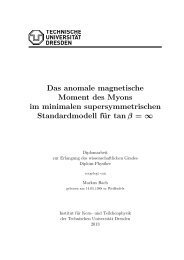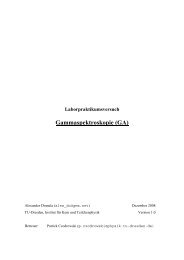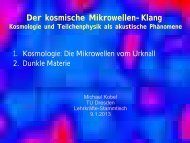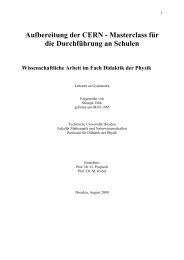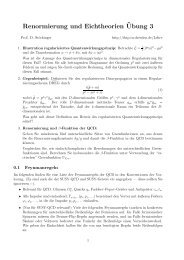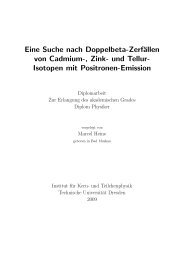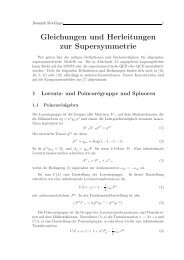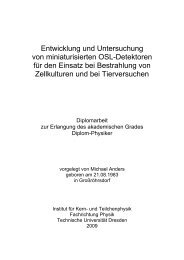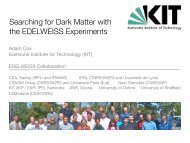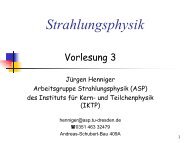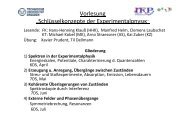a design study for a cobra upgrade to - Institut für Kern- und ...
a design study for a cobra upgrade to - Institut für Kern- und ...
a design study for a cobra upgrade to - Institut für Kern- und ...
Create successful ePaper yourself
Turn your PDF publications into a flip-book with our unique Google optimized e-Paper software.
90 A FIRST APPENDIX<br />
A.2 Reports about CsI:Tl detec<strong>to</strong>rs<br />
Scintillation detec<strong>to</strong>rs are common used detec<strong>to</strong>r systems and plenty of<br />
reports describe the assemblies and achieves resolution. With an final<br />
focus on CsI:Tl scintillation detec<strong>to</strong>rs of this thesis, mainly reports of<br />
these crystals, comparing between different readout devices, couplings<br />
and crystal wrapping are presented.<br />
For the BARBAR collaboration Brose et al. [39] reported pho<strong>to</strong>electron<br />
yields of CsI:Tl crystals with different crystal wrapping and readout.<br />
They used crystals of 6x5 cm 2 front face, 6x6 cm 2 rear face and a length<br />
of 36 cm.<br />
The crystal wrapping improved the light yield and uni<strong>for</strong>mity. A crystal<br />
wrapping with two layers of DuPont Tyvek 1056 D (160 µm) or three<br />
layers of 38 µm thick Teflon PTFE improves the light yield by 4 times<br />
compared <strong>to</strong> no wrapping. One layer Al foil aro<strong>und</strong> the two layers<br />
of DuPont Tyvek 1056 D yields an improvement of the light yield of 5<br />
times the light yield without wrapping. The wrapping also improves<br />
the uni<strong>for</strong>mity of light output and reduces cross talk between the crystals.<br />
As readout device, three different systems were used, a PMT, a<br />
PIN diode coupled directly <strong>to</strong> the crystal and diodes coupled <strong>to</strong> a wave<br />
length shifter.<br />
The light yields of 74 % <strong>for</strong> a 5 cm diameter PMT (Hamamatsu R669)<br />
with multialkali pho<strong>to</strong>cathode, coupled <strong>to</strong> the rear face of the crystal<br />
with a minimal air gap, was only given in this article relative <strong>to</strong> a cubic<br />
CsI:Tl standard crystal (25 mm edge length). They measured the<br />
uni<strong>for</strong>mity of light output <strong>for</strong> 18 different positions of a 137 Cs source<br />
(662 keV) <strong>for</strong> the PMT, being within ±2%.<br />
Thereafter two Hamamatsu S2744-08 diodes (10x20 mm 2 active area)<br />
were coupled with optical grease and glue <strong>to</strong> the rear face of the crystal.<br />
This readout yields aro<strong>und</strong> 8500 pho<strong>to</strong>electrons/MeV with en electronic<br />
noise level of 110 keV at the 1275 keV line of 22 Na. The pho<strong>to</strong><br />
peak position of a 137 Cs source could not be determined with the diode<br />
readout.<br />
Finally two Hamamatsu S 3588-03 (mod 5400) with 3x3 mm 2 active area<br />
were coupled via a wave length shifter <strong>to</strong> the crystal rear face. The<br />
wave length shifter consisted of fluorescent dyes, dissolved in 3 mm<br />
thick lucite (PMMA) plates and covered the hole rear crystal surface.<br />
The tested BASF Lumogen F red 300 and Roehm 2466 P have maximum<br />
absorption at 440, 530-540 and 560-570 nm and the fluorescence<br />
emission at aro<strong>und</strong> 625 nm, where the quantum efficiency of pho<strong>to</strong>diodes<br />
is higher. The WLS plate was coupled via an air gap of 0.5 mm<br />
<strong>to</strong> the crystal and one (and later two) S 3588-03 (mod 5400) pho<strong>to</strong>di-


